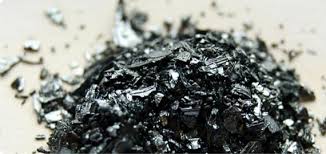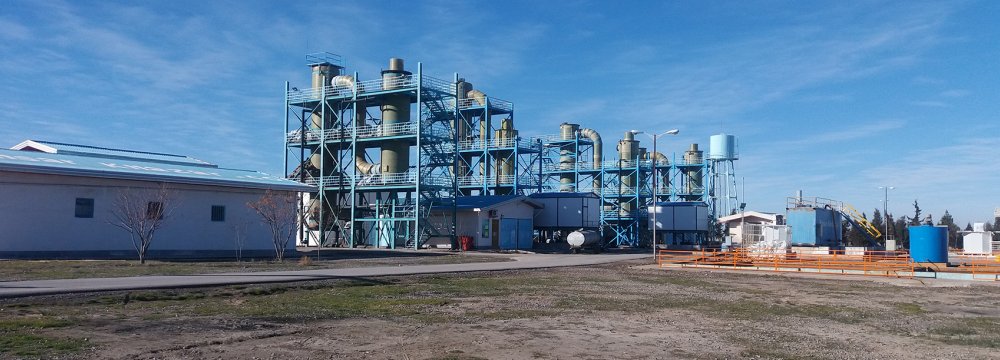
Iran the Only Mideast Producer of Iodine

As the only producer of iodine in the Middle East, Iran exported 360 tons of the product worth more than $6.34 million in the last Iranian year (ended March 20, 2017), registering a 67.5% year-on-year rise in weight but no significant change in value, the head of Golestan Industries, Mines and Trade Organization told Financial Tribune.

"During the five months to August 22, around 100 tons of iodine worth $2 million were exported to our customers, including Italy, Austria, China and India, among others. Since there are not many countries producing iodine in the world, we face no difficulties in exporting the product," Hossein-Qoli Qavanlou added.
Part of last year's exports pertained to iodine produced in the preceding year.
Golestan, according to the official, is the only province with iodine resources in Iran, which is extracted from groundwater at a depth of 800 to 1,000 meters.
"Iran's iodine is of very high quality and readily meets the global standards," he said.
"The province's first iodine factory was launched about 10 years ago and Iran joined the ranks of very few countries that produce iodine. We started off by producing 65 tons and succeeded in increasing the amount to between 365 tons and 370 tons last year."
Chile is the biggest producer of iodine in the world, followed by Japan, the US, Azerbaijan, Turkmenistan and Indonesia.
Imports Despite Self-Sufficiency
Qavanlou noted that domestic demand for iodine stands at close to 100 tons per year and local production can sufficiently meet this need, yet 50-60 tons of the product are imported every year.
"The Ministry of Industries, Mining and Trade cannot ban the imports but thankfully, has stopped allocating preferential foreign exchange rates to iodine imports that are lower than the open market rates. This happened last year and has rendered imports less profitable ever since," he said.
We have also called for raising iodine import tariffs from the current 4-5% to 15%, which we hope will take effect starting next year."
Future Plans
The official announced that an iodine factory with a production capacity of 250 tons will be launched in the next two months.
"Another factory with a capacity to produce 150-200 tons of the mineral is being built, which will officially start operating by the yearend. This means, by March 2018, our production capacity will reach between 770 and 820 tons. Plans are to increase production to around 2,000 tons by the end of the Sixth Five-Year Development Plan (2017-22)," he said.
Development plans are laws drafted by the government and ratified by parliament every five years since 1991 and are meant to provide the broad directions for a wide range of economic reforms and social priorities.
"The targeted production figure is much higher than the domestic demand," Qavanlou said, noting that talks are ongoing for iodine downstream and processing industries to be established in the province.
"We are looking for investments in the field to produce iodine derivatives and products," he added.
Iodine, according to the official, is used across a wide range of industries, including high-tech, production of LEDs and LCDs, pharmaceuticals, petrochemicals, foodstuff and livestock disinfectants.
Qavanlou concluded by saying that Iran's iodine resources are located in the border city of Incheh Borun in Golestan Province.
"This provides the ground for creating numerous jobs for the local people. Each iodine-producing factory can generate 120 to 150 direct jobs. Therefore, we expect the government to lend its support to this potentially lucrative industry," he said.


Trump weighs using $2 billion in CHIPS Act funding for critical minerals

Codelco cuts 2025 copper forecast after El Teniente mine collapse

Electra converts debt, launches $30M raise to jumpstart stalled cobalt refinery

Barrick’s Reko Diq in line for $410M ADB backing

Abcourt readies Sleeping Giant mill to pour first gold since 2014

Nevada army depot to serve as base for first US strategic minerals stockpile

SQM boosts lithium supply plans as prices flick higher

Viridis unveils 200Mt initial reserve for Brazil rare earth project

Tailings could meet much of US critical mineral demand – study

Kyrgyzstan kicks off underground gold mining at Kumtor

Kyrgyzstan kicks off underground gold mining at Kumtor

KoBold Metals granted lithium exploration rights in Congo

Freeport Indonesia to wrap up Gresik plant repairs by early September

Energy Fuels soars on Vulcan Elements partnership

Northern Dynasty sticks to proposal in battle to lift Pebble mine veto

Giustra-backed mining firm teams up with informal miners in Colombia

Critical Metals signs agreement to supply rare earth to US government-funded facility

China extends rare earth controls to imported material

Galan Lithium proceeds with $13M financing for Argentina project

Kyrgyzstan kicks off underground gold mining at Kumtor

Freeport Indonesia to wrap up Gresik plant repairs by early September

Energy Fuels soars on Vulcan Elements partnership

Northern Dynasty sticks to proposal in battle to lift Pebble mine veto

Giustra-backed mining firm teams up with informal miners in Colombia

Critical Metals signs agreement to supply rare earth to US government-funded facility

China extends rare earth controls to imported material

Galan Lithium proceeds with $13M financing for Argentina project

Silver price touches $39 as market weighs rate cut outlook

















